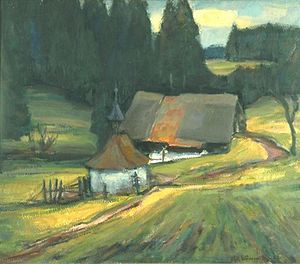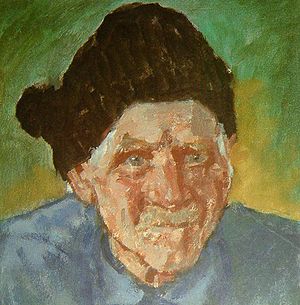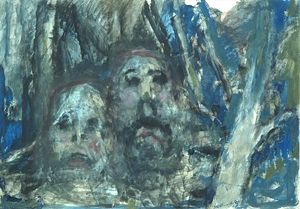
Wilhelm Kimmich
Encyclopedia
Wilhelm Kimmich was a German painter and is considered one of the most important Black Forest painters of the 20th century.
as early as 1909. He had a business training and was a soldier in World War I
from 1916 to 1918 and returned from a POW camp in 1920. From 1926 till his retirement in 1960 he worked for the Lauterbach Volksbank
, since 1929 as a member of the executive board.
He took also part in World War II
since 1943 and was released from French captivity in 1946.
Since 1916 Kimmich had been active as a draughtsman and painter and he took drawing lessons with Hans Lembke in Freiburg in the 1920s and with Hermann Gehri in the 1930s, although he later referred to himself as a "self-taught" painter.
Since 1934 Kimmich took part in group exhibitions and had his first individual exhibition in 1937.

 Since 1956 Wilhelm Kimmich, together with his painter friend Professor Hermann Anselment
Since 1956 Wilhelm Kimmich, together with his painter friend Professor Hermann Anselment
(1905-1981), had travelled to Ticino
and to Italy
.
Although, as a result of these trips, he created landscapes depicting those southern areas Kimmich soon returned to his proper motifs, i. e. the Black Forest and its people. Since the middle of the 1950s he "completely refurbished" Black Forest painting from a stylistic point of view. This accomplishment determines Kimmich's standing in the history of art in the southwest of Germany.
As for his stylistic influences, Kimmich stuck to traditional values. He admitted to influences of Impressionism
as well as Expressionism
and in his works the influence of Claude Monet
and Paul Cézanne
are visible as well as that of Henri Matisse
and Emil Nolde
.
In 1970 Kimmich moved to his new house on Lauterbach's Fohrenbühl
, where he had his own studio. He was awarded an honorary citizenship of his birthplace Lauterbach in 1977
His wife Hildegard Lutz from Munderkingen
, whom he had married in 1949, died in 1980. For the last four years of his life Wilhelm Kimmich lived together with Elisabeth Sandfort.
Until his death on September 18th, 1986 the painter had created about 2,000 paintings, in addition to numerous drawings and sketches.
What works were still his own were bequeathed to the municipality of Lauterbach along with the condition to present them to the public in a foundation.
 Two years after Kimmich's death, Lauterbach established a gallery in the old town hall, where many of Kimmich's paintings, but also works of other, in particular regional, artists are shown. Initiated by Manfred Schlayer (1934 − 2005), the longstanding mayor of Lauterbach, the Kunstverein Wilhelm Kimmich (see external links) was founded in 1997.
Two years after Kimmich's death, Lauterbach established a gallery in the old town hall, where many of Kimmich's paintings, but also works of other, in particular regional, artists are shown. Initiated by Manfred Schlayer (1934 − 2005), the longstanding mayor of Lauterbach, the Kunstverein Wilhelm Kimmich (see external links) was founded in 1997.
This voluntary association
is instrumental in preserving and presenting Kimmich's work in the gallery, and in publishing a complete register of his legacy.
The first part of volume I was published in 1999 and comprises the paintings in private possession.
The second part of volume I, comprising the paintings in private possession, was published in 2007.
The early years
From 1904 to 1911 Wilhelm Kimmich attended primary school in Lauterbach and made first attempts in drawingDrawing
Drawing is a form of visual art that makes use of any number of drawing instruments to mark a two-dimensional medium. Common instruments include graphite pencils, pen and ink, inked brushes, wax color pencils, crayons, charcoal, chalk, pastels, markers, styluses, and various metals .An artist who...
as early as 1909. He had a business training and was a soldier in World War I
World War I
World War I , which was predominantly called the World War or the Great War from its occurrence until 1939, and the First World War or World War I thereafter, was a major war centred in Europe that began on 28 July 1914 and lasted until 11 November 1918...
from 1916 to 1918 and returned from a POW camp in 1920. From 1926 till his retirement in 1960 he worked for the Lauterbach Volksbank
Co-operative Bank
The Co-operative Bank plc is a commercial bank in the United Kingdom and Guernsey, with its headquarters in Manchester.The bank markets itself as an ethical bank, and refuses to invest in companies involved in the arms trade, global climate change, genetic engineering, animal testing and use of...
, since 1929 as a member of the executive board.
He took also part in World War II
World War II
World War II, or the Second World War , was a global conflict lasting from 1939 to 1945, involving most of the world's nations—including all of the great powers—eventually forming two opposing military alliances: the Allies and the Axis...
since 1943 and was released from French captivity in 1946.
Since 1916 Kimmich had been active as a draughtsman and painter and he took drawing lessons with Hans Lembke in Freiburg in the 1920s and with Hermann Gehri in the 1930s, although he later referred to himself as a "self-taught" painter.
Since 1934 Kimmich took part in group exhibitions and had his first individual exhibition in 1937.
The years of artistic maturity


(1905-1981), had travelled to Ticino
Ticino
Canton Ticino or Ticino is the southernmost canton of Switzerland. Named after the Ticino river, it is the only canton in which Italian is the sole official language...
and to Italy
Italy
Italy , officially the Italian Republic languages]] under the European Charter for Regional or Minority Languages. In each of these, Italy's official name is as follows:;;;;;;;;), is a unitary parliamentary republic in South-Central Europe. To the north it borders France, Switzerland, Austria and...
.
Although, as a result of these trips, he created landscapes depicting those southern areas Kimmich soon returned to his proper motifs, i. e. the Black Forest and its people. Since the middle of the 1950s he "completely refurbished" Black Forest painting from a stylistic point of view. This accomplishment determines Kimmich's standing in the history of art in the southwest of Germany.
As for his stylistic influences, Kimmich stuck to traditional values. He admitted to influences of Impressionism
Impressionism
Impressionism was a 19th-century art movement that originated with a group of Paris-based artists whose independent exhibitions brought them to prominence during the 1870s and 1880s...
as well as Expressionism
Expressionism
Expressionism was a modernist movement, initially in poetry and painting, originating in Germany at the beginning of the 20th century. Its typical trait is to present the world solely from a subjective perspective, distorting it radically for emotional effect in order to evoke moods or ideas...
and in his works the influence of Claude Monet
Claude Monet
Claude Monet was a founder of French impressionist painting, and the most consistent and prolific practitioner of the movement's philosophy of expressing one's perceptions before nature, especially as applied to plein-air landscape painting. . Retrieved 6 January 2007...
and Paul Cézanne
Paul Cézanne
Paul Cézanne was a French artist and Post-Impressionist painter whose work laid the foundations of the transition from the 19th century conception of artistic endeavour to a new and radically different world of art in the 20th century. Cézanne can be said to form the bridge between late 19th...
are visible as well as that of Henri Matisse
Henri Matisse
Henri Matisse was a French artist, known for his use of colour and his fluid and original draughtsmanship. He was a draughtsman, printmaker, and sculptor, but is known primarily as a painter...
and Emil Nolde
Emil Nolde
Emil Nolde was a German painter and printmaker. He was one of the first Expressionists, a member of Die Brücke, and is considered to be one of the great oil painting and watercolour painters of the 20th century. He is known for his vigorous brushwork and expressive choice of colors...
.
In 1970 Kimmich moved to his new house on Lauterbach's Fohrenbühl
Fohrenbühl
Fohrenbühl is a mountain of Baden-Württemberg, Germany....
, where he had his own studio. He was awarded an honorary citizenship of his birthplace Lauterbach in 1977
His wife Hildegard Lutz from Munderkingen
Munderkingen
Munderkingen is a town in the district of Alb-Donau in Baden-Württemberg in Germany. It is situated on the Danube, 9 km southwest of Ehingen, and 31 km southwest of Ulm....
, whom he had married in 1949, died in 1980. For the last four years of his life Wilhelm Kimmich lived together with Elisabeth Sandfort.
The last years
Kimmich's friend and biographer Egon Rieble comments on Kimmich's last period of artistic creativity: "In his late period of artistic production Kimmich gives up the art of beautiful appearance, to render individual impression to his imagination. In Kimmich's last paintings the fragility of the traditional Black Forest myth is felt in a menacing way."(see Kimmich's last painting)Until his death on September 18th, 1986 the painter had created about 2,000 paintings, in addition to numerous drawings and sketches.
What works were still his own were bequeathed to the municipality of Lauterbach along with the condition to present them to the public in a foundation.
Kimmich's standing as a German painter
The emphasis on Kimmich's role as a painter of the Black Forest has often led to neglecting other aspects of his work. There are a number of paintings and drawings of other areas in the South West of Germany and − as mentioned before − of the Ticino and Northern Italy. He was impressed by the people in his neighbourhood and portrayed them very accurately, e. g. his neighbour Oberbauer David in 1972.Kimmich's Legacy

This voluntary association
Voluntary association
A voluntary association or union is a group of individuals who enter into an agreement as volunteers to form a body to accomplish a purpose.Strictly speaking, in many jurisdictions no formalities are necessary to start an association...
is instrumental in preserving and presenting Kimmich's work in the gallery, and in publishing a complete register of his legacy.
The first part of volume I was published in 1999 and comprises the paintings in private possession.
The second part of volume I, comprising the paintings in private possession, was published in 2007.
Further reading
- Egon Rieble: Wilhelm Kimmich - der Maler des Schwarzwalds, Stuttgart 1982
- Kunstverein Wilhelm Kimmich et al.(edd.):Wilhelm Kimmich: Werkverzeichnis, Band 1, Das malerische Werk, Teil 1, Gemälde in öffentlichem Besitz, Lauterbach-Rottweil 1999 ISBN 3-928869-11-6
- Kunstverein Wilhelm Kimmich u.a.(Hrsg.): Wilhelm Kimmich: Werkverzeichnis, Band 1, Das malerische Werk, Teil 2, Gemälde in Privatbesitz, Lauterbach–Rottweil 2007,ISBN 3-928869-22-5

